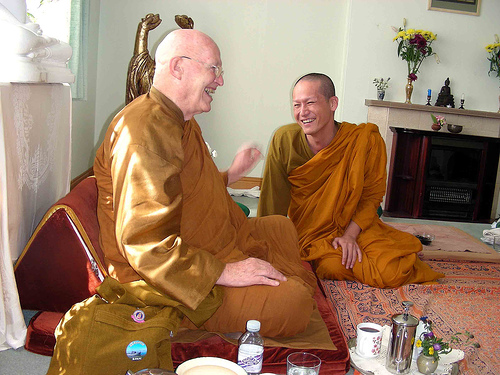- Ajahn Sumedho
Infobox Person
name = Ajahn Sumedho

caption = Luang Por Ajahn Sumedho (left).
birth_name = Robert Jackman
birth_date =July 27 ,1934
birth_place =Seattle, Washington , USA
death_date =
death_place =
death_cause =
resting_place =
resting_place_coordinates =
residence =
nationality =
other_names =
known_for =
education =
employer =
occupation =Buddhist teacher
title = Luang Por Ajahn Sumedho
salary =
networth =
height =
weight =
term =
predecessor =Ajahn Chah
successor =
party =
boards =
religion =Theravada Buddhism
spouse =
partner =
children =
parents =
relatives =
website =
footnotes =Luang Por Ajahn Sumedho ( _th. อาจารย์สุเมโธ) (born Robert Jackman,
July 27 ,1934 ,Seattle ) is the most senior representative of theThai Forest Tradition ofTheravada Buddhism in the West. The word "Ajahn " is not a proper name, but a title which means "Teacher" in Thai. He is also affectionately known among his students as "หลวงพ่อ " ("Luang Por ") which means "Venerable Father" in Thai. He has been an ordainedbhikkhu for 40 years and a seminal figure in the transmission of the Buddhadhamma to the West. He is currently the abbot ofAmaravati Buddhist Monastery in theUnited Kingdom .Biography
Ajahn Sumedho (Robert Jackman) was born in
Seattle, Washington in 1934. Beginning at the age of eighteen, he served overseas as a medic in theUnited States navy for four years, including the period of theKorean War . Following his military service, he completed a Bachelor of Arts degree in Far Eastern Studies and, in 1963, graduated with a Masters Degree in South Asian Studies at theUniversity of California , Berkeley. He served in thePeace Corps as an English teacher inBorneo from 1964 to 1966, following a one-year stint as a social worker for theRed Cross . In 1966, Ajahn Sumedho was ordained as anovice monk (samanera ) atWat Sri Saket inNong Khai , northeastThailand , and received full ordination, as a bhikkhu, in May of the following year.Following this, he spent the next ten years from 1967-1977 at
Wat Nong Pa Pong , studying under the highly venerated teacher,Ajahn Chah . Since that time, he has been regarded as the most influential Western disciple of Ajahn Chah. In 1975 he helped to establish and became the first abbot of the International Monastery,Wat Pa Nanachat in northeast Thailand founded by Ajahn Chah for training his non-Thai students. In 1977, Ajahn Sumedho accompanied Ajahn Chah on a visit toEngland . After observing a keen interest inBuddhism among Westerners, Ajahn Chah encouraged Ajahn Sumedho to remain in England for the purpose of establishing a branch monastery in the UK. This becameCittaviveka Forest Monastery , inWest Sussex .Ajahn Sumedho was granted authority to ordain others as monks shortly after he established Cittaviveka Forest Monastery. He then established a
ten precept ordination lineage for women, "Siladhara ".Ajahn Sumedho is currently the abbot of
Amaravati Buddhist Monastery nearHemel Hempstead in England, which was established in 1984. It is part of the network of monasteries and Buddhist centres in the lineage of Ajahn Chah, which now extends across the world, from Thailand,New Zealand andAustralia , toEurope ,Canada and the United States. Ajahn Sumedho has played an instrumental role in building this international monastic community.Teachings
Ajahn Sumedho is a prominent figure in the Thai Forest Tradition. His teachings are very direct, practical, simple, and down to earth. In his talks and sermons he stresses the quality of immediate intuitive awareness and the integration of this kind of awareness into daily life. Like most teachers in the Forest Tradition, Ajahn Sumedho tends to avoid intellectual abstractions of the Buddhist teachings and focuses almost exclusively on their practical applications, that is, developing wisdom and compassion in daily life. His most consistent advice can be paraphrased as to see things the way that they actually are rather than the way that we want or don't want them to be ("Right now, it's like this..."). He is known for his engaging and witty communication style, in which he challenges his listeners to practice and see for themselves. Students have noted that he engages his hearers with an infectious sense of humor, suffused with much loving kindness, often weaving amusing anecdotes from his experiences as a monk into his talks on meditation practice and how to experience life ("Everything belongs").
Sound of Silence
A meditation technique taught and used by Ajahn Sumedho is the "Sound of Silence" [Disputed] (also known -- in the Hatha Yoga Pradipika, for example -- as the Nada tone). Listening to, and resting in, this inner sound produces a peaceful, non-reactive mind in which intuitive wisdom can and does arise. The "Sound of Silence" is also the title of one of Ajahn Sumedho's books (published by Wisdom in 2007).
ee also
*
Thai Forest Tradition
*Ajahn Chah External links
* [http://www.buddhanet.net/masters/sumedho.htm BuddhaNet entry on Ajahn Sumedho]
* [http://www.amaravati.org/abm/english/lp.html Profile of Ajahn Sumedho on Amaravati]
* [http://www.amaravati.org/abm/english/tch.html Books of Ajahn Sumedho] (PDF ,HTML )
* [http://www.dhammatalks.org.uk/sumed.htm Talks by Ajahn Sumedho] (MP3 )
* [http://uk.youtube.com/watch?v=fwVh9ueXWZ0 Video of interview on YouTube] English with Portuguese sub titles.
Wikimedia Foundation. 2010.
